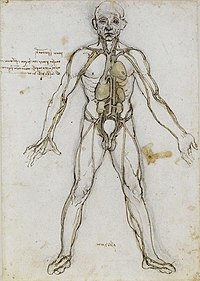
Photo from wikipedia
c-Kit (CD117) is a type III receptor tyrosine kinase that activates a downstream signaling cascade on binding to stem cell factor. Studies from the past 3 decades have demonstrated the… Click to show full abstract
c-Kit (CD117) is a type III receptor tyrosine kinase that activates a downstream signaling cascade on binding to stem cell factor. Studies from the past 3 decades have demonstrated the expression of c-Kit in various cell types including embryonic, spermatogonial, and hematopoietic stem cells as well as differentiated cells such as melanocytes, neurons, Leydig cells in the testis, and mast cells.1 The expression of c-Kit to mark a stem cell population in the adult heart was initially reported by Beltrami et al2 and subsequent studies to validate or extend this work has led to tremendous conflicts and controversies. Much of the disagreements involve inconsistent results and discrepant conclusions that stem from the use of distinct tools and models that each carries its own advantages and disadvantages. In general, studies that used single allele knockin replacement of the endogenous C-KIT locus have demonstrated fewer labeled cells than studies that utilized transgenic reporters (discussed below). Furthermore, a functional role for c-Kit signaling in cardiac cells has been raised but not convincingly demonstrated. Article, see p 57 After the initial report of c-Kit as a marker for adult cardiac stem cell (CSC),2 numerous studies describe the isolation, expansion, and in vitro differentiation of adult c-Kit+ cardiac cell into multiple cardiovascular cell lineages (for a review see Hesse et al1). The expression of c-Kit in cardiac cells declines from embryonic stages and is nearly completely absent in the adult heart. In developing embryos, a population of cardiomyogenic c-Kit+ cardiac progenitors is present in the neural crest.3 The ability of a rare number of neonatal c-Kit+ nonmyocytes to differentiate in vitro into beating cardiomyocytes were shown by 2 independent groups.4,5 Interestingly, neither group was able to demonstrate cardiomyogenic differentiation from adult c-Kit+ nonmyocytes …
Journal Title: Circulation Research
Year Published: 2018
Link to full text (if available)
Share on Social Media: Sign Up to like & get
recommendations!